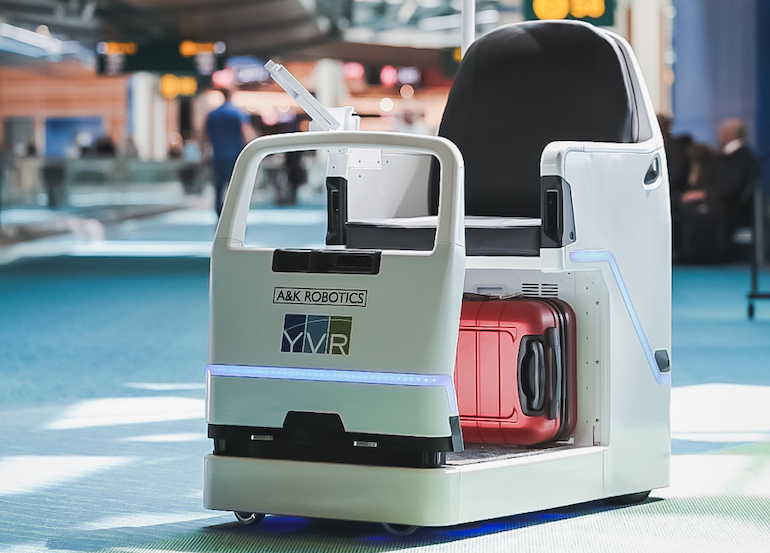
Micromobility trials in Vancouver International Airport could lead to wider deployments. Source: A&K Robotics
Demand for mobility assistance in spaces such as airports is increasing as populations age and more people travel. Robots and autonomous vehicles can help meet that demand amid persistent labor shortages, according to A&K Robotics Inc.
Since 2016, the Vancouver, B.C.-based company has been developing electric micromobility platforms and self-driving robotic pods to help improve quality of life and environmental sustainability.
“We’re not replacing wheelchairs in airports and other facilities,” said Jessica Yip, co-founder of A&K Robotics. “Our pods are intended to help people with mobility limitations.”
A&K Robotics rolls out airport robots in phases
In July, A&K Robotics said it is bringing its Cruz self-driving robotic pods at the Vancouver International Airport (YVR). The company had already tested its systems at the Hartsfield-Jackson Atlanta International Airport in 2022.

Jessica Yip, co-founder of A&K Robotics
“[Co-founder] Matt [Anderson] and I envisioned going to several airports when we started the company,” acknowledged Yip. “We then decided to focus on quality over quantity.”
“We had previously delivered one or two robots for relatively short durations,” she told The Robot Report. “It takes resources to bring a team and a 400-lb. mobile robot to each facility.”
“We knew we’d take a multi-stage approach to commercialization,” added Yip. “We researched the problem space and came to the conclusion that the automated mobility experience is really important to an airport’s customers — and to its business.”
“We’re prioritizing airports with high standards for operations and efficiency versus those that want robots as a novelty for marketing,” she said. “We’re focused on real-world operations and building our product to enable airports and airlines to have a high level of customization for branding.”
Finding value at the dawn of digitalization
In most airports, wheelchairs and shuttles must be manually fetched and brought to passengers and gates, noted Yip. Just knowing where they are in million-square-foot facilities or even parking lots can be a challenge requiring staffers to walk long distances and spend precious time.
“YVR has 10 million sq. ft., fire and ambulance service, IT, wildlife and aquariums, and plumbing — it’s actually a small city,” Yip said. “We have a great opportunity to test a mobility use case where there’s demand right now.”
“Our pods are connected IoT [Internet of Things] devices, and we’re building dashboards and tools for airports to know where their fleets are and their battery status,” she explained. “By digitizing control, they could even remotely deploy a pod to a gate.”
“We’re just on the cusp of learning what value we can bring with robots enabled by AI, sensors, and data,” she said.
Partnerships to boost Canadian robotics
Last month, A&K Robotics announced strategic partnerships to promote the adoption of robotics across Canada. It is working with telecommunications leader Bell Canada, battery and charging provider Delta-Q Technologies, and assistive charity the Rick Hansen Foundation to build an ecosystem of robots, cloud infrastructure, electric vehicle systems, and new manufacturing facilities.
“Some critical technologies are necessary for self-driving systems to scale,” explained Yip. “For quality of service, we need 5G connectivity, and we’re working with Amazon Web Services for cloud services to deploy fleets.”
“When robotic sensors pick up environmental changes, our systems will perform better at scale than in ones or twos,” she added. “They can detect if a gate is boarding and divert other robots to avoid congestion.”
A&K Robotics expects micromobility to grow globally
The global micromobility market could expand from $79.1 billion (U.S.) to $243.2 billion by 2030 at a compound annual growth rate of 17.4%, predicted Maximize Market Research Pvt. Ltd. It cited advances in IoT and battery technology. A&K Robotics said it is poised to lead in that growth.
“We’re currently focused on a few strategic accounts in the Canada, the U.S., and Europe that each have five to 10 units,” said Yip. “We need boots on the ground and want to develop an initial model to implement mobility that we can then replicate.”
What are some of the differences between regions?
“In the EU, the responsibility for providing wheelchair assistance lies with the airport and its service provider, while in North America, that responsibility is with the airline, from budget to luxury,” replied Yip. “From a passenger standpoint, the EU model is better, especially if one gets bounced around among connecting flights.”
North American airports are beginning to realize that they need to invest in mobility assistance for older passengers, she said.
“Our long-term goal is to integrate mobility in a way that’s sustainable for us and the airport,” concluded Yip. “Airports are also launchpads for smart-city applications. It doesn’t make sense to deliver a pizza with a five-seater car; there have to be more sustainable options.”

 1 month ago
17
1 month ago
17









 English (US) ·
English (US) ·